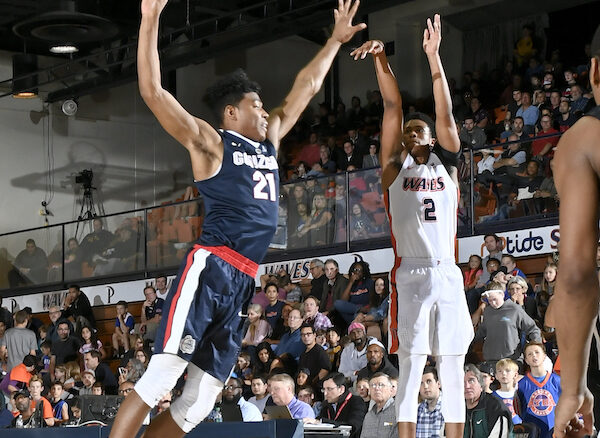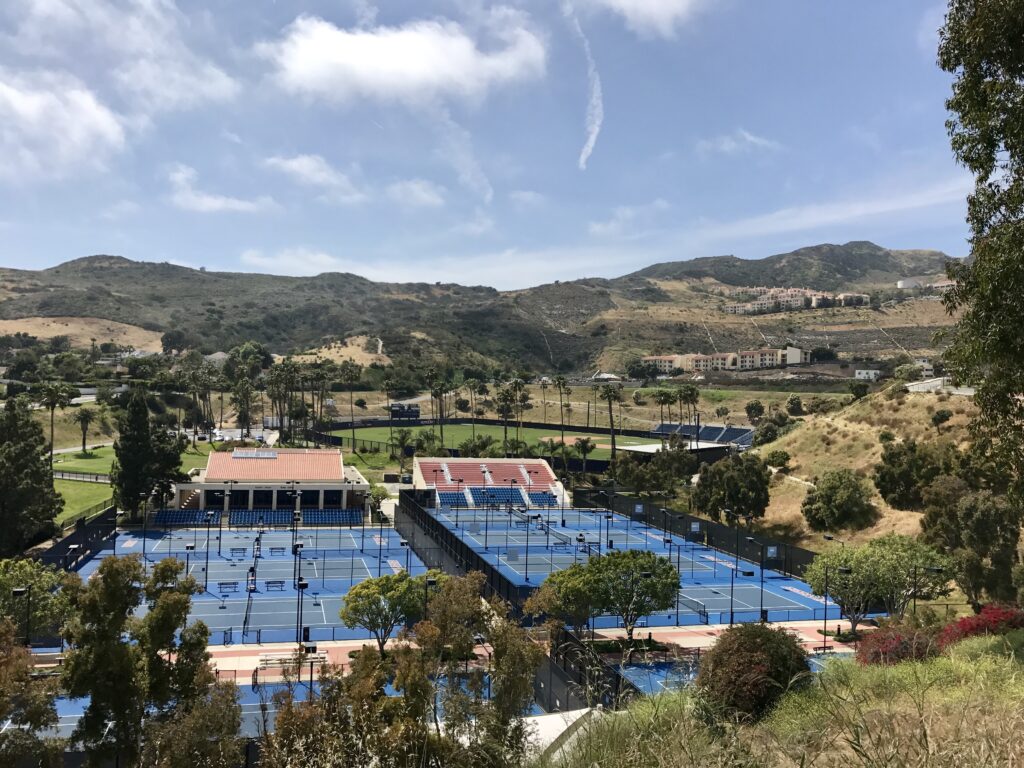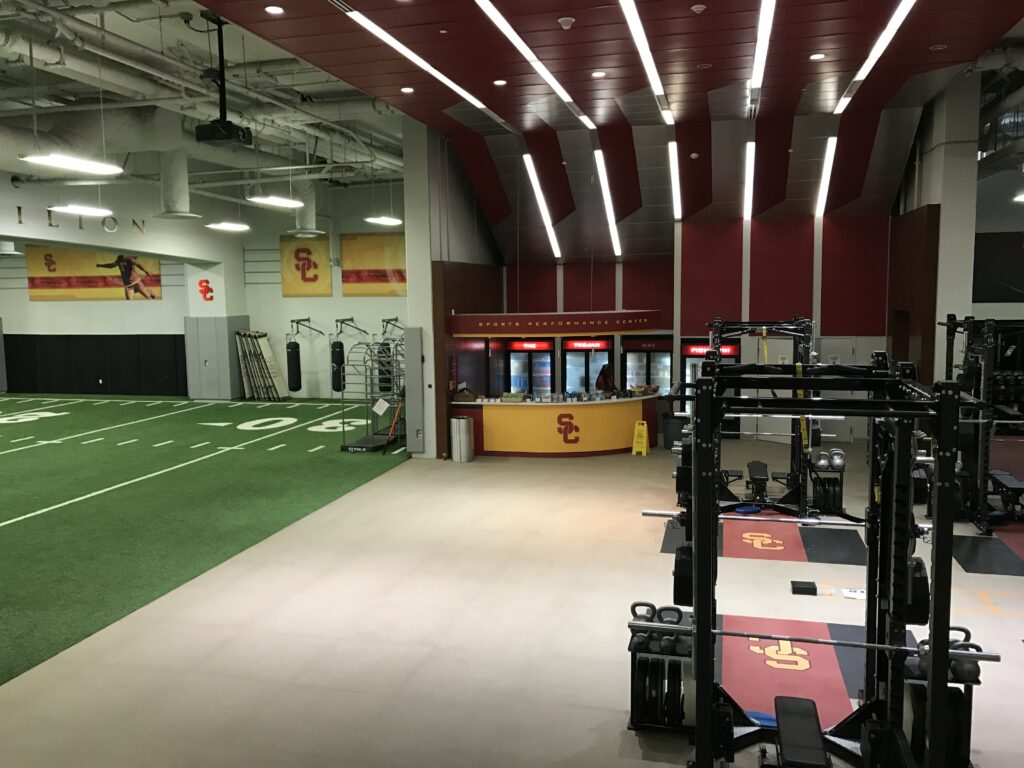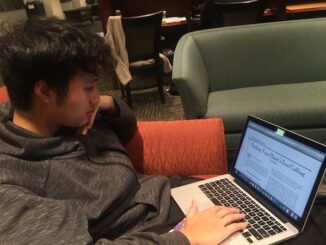
The ongoing debate about collegiate student-athlete compensation is much more than a yes or no question.
The National Collegiate Athletic Association (NCAA) generated more than $1 billion in revenue in 2017, Alex Kirshner wrote in a March 2018 SB Nation article. Yet, only 24 NCAA member schools earned more than they spent on their athletic departments in 2014, Brian Burnsed wrote in an NCAA article. This begs the question of whether student-athletes at the schools earning money, or any student-athlete at all, should see some of that money.
Caption: This map shows the top 24 revenue generating NCAA member schools in 2017, as well as their athletic conference. All 24 are part of the ‘Power Five’ conferences, the unofficial term for the five wealthiest athletic conferences.
“It is going to be very difficult to maintain the current structure of intercollegiate athletics if student-athletes have to be paid anywhere beyond the benefits that they are currently receiving,” Pepperdine Athletic Director Steve Potts said.
Experts, students and student-athletes around Pepperdine and in the surrounding area generally agreed that education is the most important aspect of collegiate athletics programs. However, interviewees raised many different complexities and arguments regarding student-athlete compensation and NCAA regulations.
How is the NCAA revenue distributed? Could student-athletes legally be considered employees? Why do certain NCAA regulations restrict endorsements, media appearances and outside revenue? Would paying student-athletes even be legally or institutionally possible?
Characterizing the NCAA
A common misconception about the NCAA is that the association is a large group of faceless people pocketing the income from television deals and making rules to undermine student-athletes’ rights.
In reality, the NCAA is simply composed of its member institutions, and most of the profits from college basketball are redistributed to the schools or to fund other NCAA championship events.
“The bylaws in the [NCAA] manual are proposed by member institutions and conferences, voted on by member institutions,” said Amanda Kurtz, Pepperdine’s associate director of Athletics for Academics and Compliance.
March Madness funds about 80 percent of the operation of the entire NCAA, said John Watson, the coordinator of Pepperdine’s sports administration major and a former committee member for the NCAA and the West Coast Conference.
Despite the redistribution of this money, all but about the top 10 percent of NCAA Division I athletic programs spend more than they earn.
“Many more schools saw their expenses exceed their revenue, requiring their colleges and universities to cover the shortfall,” Burnsed wrote.
This raises institutional questions of the value of an athletic program for its student-athletes and its students. Experts said it also presents a strong case against compensating any student-athlete other than those in major sports who turn a profit.
“The athletic departments, the schools [that lose money], are taking student funds and funds that might go into academics and putting it into athletics to try to make ends meet,” said Don Shores, a Pepperdine media production and broadcasting professor and a former NCAA Faculty Athletics representative.
Legal complications
The student-athlete compensation debate raises many legal questions, including whether student-athletes can be legally defined as employees and whether Title IX would prevent compensation from being limited to athletes in profit-earning sports.
Indeed, the issue is sticky enough that multiple officials at the University of Southern California and the University of California Los Angeles, which both have big football and men’s basketball programs, declined to be interviewed for this story.
“I do not think that every college athlete is an employee,” said Alicia Jessop, a licensed attorney, the founder of sports law site rulingsports.com and a sports administration professor at Pepperdine. “I do think that a good number of college athletes in the Division I ‘Power Five’ conferences, especially in the sports of football and men’s basketball, are employees.”
Not only do collegiate student-athletes work at least 25 hours for their sport in a typical week but some produce income for their university and all are also subject to the considerable control of their coaches, Jessop said.

“Because of our employment laws in the United States, I think it’s illegal not to compensate them for the work that they do,” Jessop said.
Student-athletes are not the only students who commit an abundance of time to extra curricular activities but they may be the only ones who potentially produce profit for the school.
“[Student-athletes] do more work than people realize; they’re practicing all the time,” said Camryn Hayes, a freshman double majoring in business and French. “If they’re actually making money for the school, I think they should benefit from that with some form of compensation.”
Unfortunately, the issue is far more complex than the definition of an employee, due to several other legal challenges.
“Title IX is going to be a major impediment to this idea of paying student-athletes,” Potts said.
Title IX, which requires equal opportunity on the basis of sex, may provide an obstacle for paying on the basis of profit, depending on the interpretation of the law. Additionally, the equity issues within universities themselves may render compensation implausible.
“If [Cal State Northridge] had to start paying student-athletes based on value that they bring . . . it would likely mean cuts to some other sports and programs,” said Shareef Amer, associate athletic director for Compliance at California State University Northridge.
A Pepp Post poll of 51 students found that 59 percent agreed with the argument “They have very limited time to earn money at a regular job,” including 59 percent of respondents who were not student-athletes.
Should student-athletes be allowed to receive income from outside sources?
Beyond disallowing school compensation, the NCAA regulations restrict student-athletes from using their student-athlete status for additional income, even on their own.
This additional income includes endorsement deals, media appearances, prize money, ability to promote their own company and even the right to their image and likeness. These restrictions could be rolled back without financial consequence to schools, Phillip Zema wrote in a May 2015 Sports, Ethics, and Philosophy journal article.
“I’m hopeful that the rules regarding amateurism and the opportunities for student-athletes to be compensated outside their sport will be an avenue for them to make money off of that,” Amer said. “Just because you’re a student-athlete, I don’t think you should be precluded from pursuing any other interests that you may have.”
The association established some of these restrictions based on Ed O’Bannon’s 2015 lawsuit against the NCAA for taking advantage of student-athletes’ image and likeness, so student-athletes did bring some of the restrictions on themselves, according to a 2015 SI Wire article.
“One player getting their own shoe brand could mess up team chemistry,” said Everett Perrot, a Pepperdine freshman men’s basketball player and undeclared major. “We can still get jobs outside of school, so the money on the side is not really an issue if you really need it.”
Other Pepperdine students tended to disagree with Perrot, and said outside income restrictions should be rolled back.
The Pepp Post poll, which included 19 student-athletes and 32 non-student-athletes, found that 59 percent of respondents believe that student-athletes should be able to receive outside income such as endorsement deals, including 59 percent of respondents who were not student-athletes.
“We should be able to have those opportunities as long as everyone has the same opportunity,” said Monique Andriuolo, a women’s basketball player and sophomore liberal arts major from Melbourne, Australia.
Are student-athletes treated unfairly or favorably?
While collegiate student-athletes may not receive a portion of revenue or receive outside income for their status, the argument can be made that they are compensated in other ways.
“A full scholarship here at Pepperdine is worth a little over $70,000 [per year],” Potts said. “When you add on to that the free medical service that all of our student-athletes receive, the free tutoring and academic support, the clothing and apparel … there are tangible benefits that flow from being a scholarship student-athlete.”
The poll found that 86 percent of respondents believe that student-athletes should be able to receive full scholarships, including 81 percent of respondents who were not Pepperdine student-athletes.
Not all student-athletes receive full scholarships or any scholarship money at all but nearly all athletes at a Division 1 school, including Pepperdine, benefit from academic and health support services, experts said.
“There’s a growing trend in student-athlete well-being,” said Amer, who previously worked in the compliance departments at USC and the University of Michigan. “The resources available to student-athletes are much better than the resources available to the general student body.”

Therefore, while being a student-athlete requires a huge time commitment, it is also an opportunity. Pepperdine student-athletes said that while student-athletes are restricted from outside income sources other than a regular job, they are not restricted from the opportunity to earn an education while playing the sport that they love.
“It’s like a job but we signed up for it,” said Mitchell Dickson, a freshman baseball player and business major. “We’re here to compete and, for some sports, to make it to the next level.”
The consensus
The purpose of the NCAA is to provide an experience for college students to engage in college athletics but these students remain students first and foremost.
“Athletics programs are supposed to be part of the educational mission of the school,” Watson said. “They have turned into two things in my opinion: an entertainment segment of the institution, which means it is a separate business … and they’ve become the minor leagues.”
Experts and students alike agreed that a university is ultimately a place of higher learning and education has an inherent value.
“I don’t think [student-athletes] should be paid but if and only if the conditions of their education are of quality,” said Joseph Chidiac, a second-year graduate student studying public policy with an emphasis on state and local government.
The Pepp Post poll found that 53 percent of respondents believe that student-athletes should not be able to receive compensation in addition to potential scholarship money, including 37 percent of student-athlete respondents and 63 percent of respondents who were not student-athletes.
This is on par with the national numbers, as Will Hobson and Emily Guskin wrote in a September 2017 Washington Post article that 52 percent of American adults still believe a full scholarship is adequate compensation for a college athlete.
The answer to the question of whether student-athletes should be compensated is complex and the debate may never end but the answer to whether student-athletes could be compensated is more than likely no, experts and students agreed. There are too many legal and institutional barriers to cross, especially the issue that all student-athletes would likely need to be paid in the name of equity and equality.
“There’s a lot more at play here than the average person realizes,” Amer said. “It would take a whole reform with the NCAA if they expect schools to pay student-athletes.”
Karl Winter completed the reporting for this story under the supervision of Dr. Christina Littlefield and Dr. Theresa de los Santos in Jour 241 in fall 2018. Dr. Littlefield supervised the web story. Dr. de los Santos supervised the video package.




